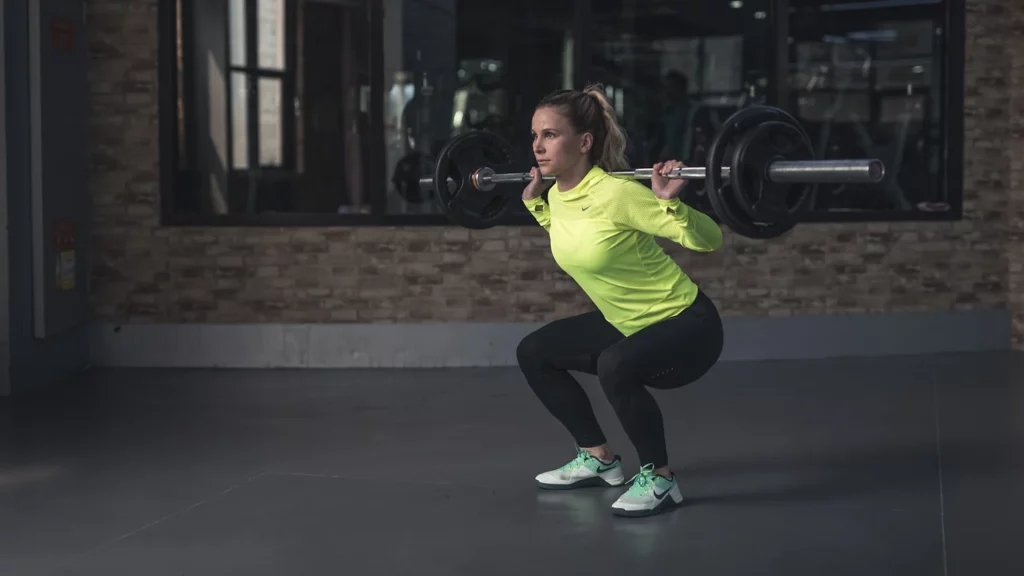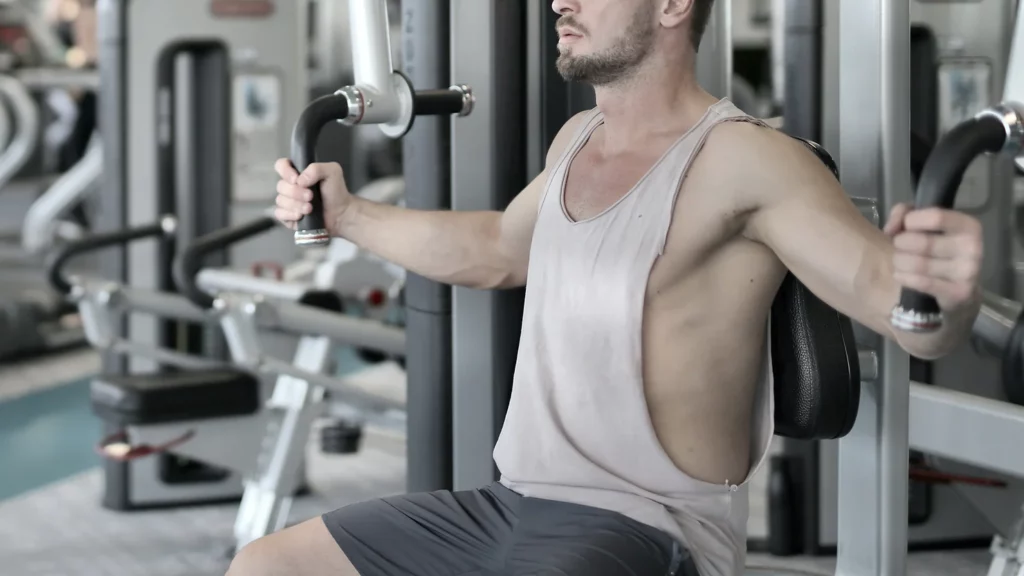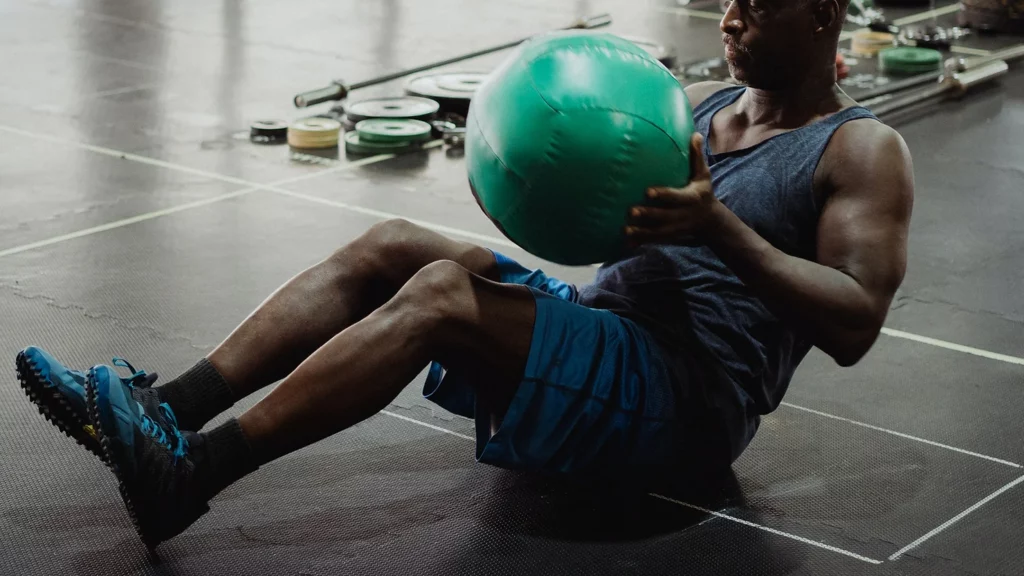What muscles do the barbell back squat work?
The primary muscle group that is targeted by the barbell back squat is the quadriceps. This exercise also works the muscles of the hamstrings, hips, and glutes. A unique aspect of this exercise is that it also works muscles in the core making it an excellent exercise for improving overall power and athletic performance.
The advantages of this exercise over other squat variations are that it allows you to use a heavier weight and the barbell is more stable on your back. Overall this is one of the best squat forms for strength and muscle building.
How to perform the barbell back squat?
Before you begin, set the barbell on a rack that is about hip-height. Once the barbell is loaded, step under it and position it across your back, resting the bar on your traps. Take a shoulder-width stance and grip the barbell with your hands slightly wider than shoulder-width apart.
Keeping your core engaged, begin to squat by pushing your hips back and bending your knees. Continue to lower yourself until your thighs are parallel to the ground. At this point, your knees should be at a 90-degree angle. From here, drive through your heels and extend your hips and knees to return to the starting position.
Cues to keep in mind when performing this movement are to keep your chest up, back straight, and not let your knees drift inward.
Common Mistakes
One of the most common mistakes people make when performing the barbell back squat is to let their knees drift inward. This puts unnecessary stress on the knees and can lead to injury. Another common mistake is to round the lower back when squatting down. This can also lead to injury. Remember to keep your chest up and back straight throughout the entire movement.
Another common issue is excessively leaning forward when squatting. This puts the barbell in a precarious position and can cause you to lose balance and fall forward. Remember to keep your weight in your heels and drive through your hips when standing up.
Finally, people often use too much weight when first starting out. This can lead to bad form and injury. Start with a light weight and gradually increase the amount of weight you are using.
Variations of the Barbell Back Squat
Variation #1: Goblet Squat
The goblet squat is a variation of the barbell back squat that can be used to improve form and technique. This variation is performed by holding a dumbbell or kettlebell close to your chest with both hands.
Start by standing with your feet shoulder-width apart and the weight held at chest level. From here, squat down by pushing your hips back and bending your knees. Continue to lower yourself until your thighs are parallel to the ground. At this point, your knees should be at a 90-degree angle. From here, drive through your heels and extend your hips and knees to return to the starting position.
Variation #2: Front Squat
The front squat is another variation of the barbell back squat that can be used to improve form and technique. This variation is performed by holding the barbell across the front of your shoulders with your hands gripping the barbell at shoulder-width apart.
Start by standing with your feet shoulder-width apart and the barbell across the front of your shoulders. From here, squat down by pushing your hips back and bending your knees. Continue to lower yourself until your thighs are parallel to the ground. At this point, your knees should be at a 90-degree angle. From here, drive through your heels and extend your hips and knees to return to the starting position.
Variation #3: Bulgarian Split Squat
The Bulgarian split squat is another variation of the barbell back squat that can be used to improve form and technique. This variation is performed by holding the barbell across the back of your shoulders with one hand and placing your back foot on a bench behind you.
Start by standing with your feet shoulder-width apart and the barbell across the back of your shoulders. Place your back foot on a bench behind you. From here, squat down by pushing your hips back and bending your knees. Continue to lower yourself until your front thigh is parallel to the ground. At this point, your knees should be at a 90-degree angle. From here, drive through your heels and extend your hips and knees to return to the starting position.
Variation #4: Overhead Squat
The overhead squat is another variation of the barbell back squat that can be used to improve form and technique. This variation is performed by holding the barbell overhead with your hands gripping the barbell shoulder-width apart.
Start by standing with your feet shoulder-width apart and the barbell overhead. From here, squat down by pushing your hips back and bending your knees. Continue to lower yourself until your thighs are parallel to the ground. At this point, your knees should be at a 90-degree angle. From here, drive through your heels and extend your hips and knees to return to the starting position.
Variation #5: Zercher Squat
The Zercher squat is another variation of the barbell back squat that can be used to improve form and technique. This variation is performed by holding the barbell in the crook of your elbows with your hands gripping the barbell at shoulder-width apart.
Start by standing with your feet shoulder-width apart and the barbell in the crook of your elbows. From here, squat down by pushing your hips back and bending your knees. Continue to lower yourself until your thighs are parallel to the ground. At this point, your knees should be at a 90-degree angle. From here, drive through your heels and extend your hips and knees to return to the starting position.
Variation #6: Sumo Squat
The sumo squat is another variation of the barbell back squat that can be used to improve form and technique. This variation is performed by placing your feet wider than shoulder-width apart with your toes pointed outwards.
Start by standing with your feet wider than shoulder-width apart and your toes pointed outwards. From here, squat down by pushing your hips back and bending your knees. Continue to lower yourself until your thighs are parallel to the ground. At this point, your knees should be at a 90-degree angle. From here, drive through your heels and extend your hips and knees to return to the starting position.
Summary
In conclusion, the barbell back squat is a great exercise for building muscle and improving form and technique. There are many variations of the barbell back squat that can be used to improve form and technique. The most common mistakes people make when performing the barbell back squat are not lowering themselves far enough, not keeping their chest up, and not driving through their heels. By following the tips in this article, you can avoid these mistakes and build muscle effectively.
Are you looking to get fit? Look no further! Our fitness programs are designed to help you build a strong and aesthetic physique. We also provide easy-to-follow routines that will fit any schedule. With our fitness programs, you'll have the tools you need to build muscle and achieve your fitness goals. Click the link below to get started!



